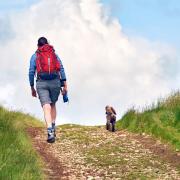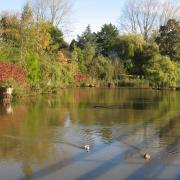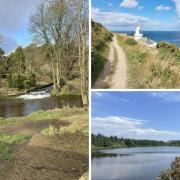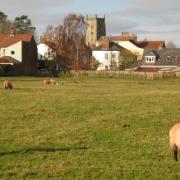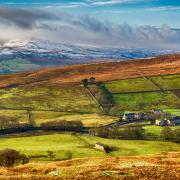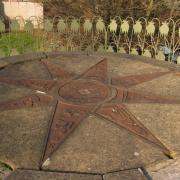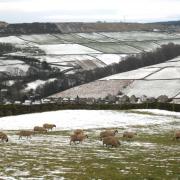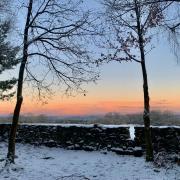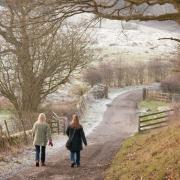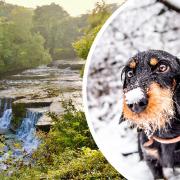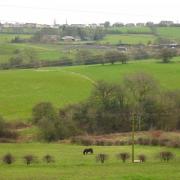Head to Nidderdale for an autumnal walk of contrasts between the peace of Fishpond Wood and the site of noisy industry at the Prosperous and Providence lead mine ruins
Directions
1. From car park walk towards village. At junction turn left on road, over bridge then left again to Bewerley. Just before a right turn opposite Fosse Beck House turn left through iron gate and up steps into Fishpond Wood. At top of four more steps, turn sharp right to icehouse and Hexagon cabin. Retrace your steps, go around the lake with water on your right. Just before kissing gate (pass through it to view Monks’ Steps on right) bear left and leave wood via wall stile.
2. Head up bank at about 10 o’clock well to the left and a lone tree. A farm soon comes into view. Go towards it and through metal field gate. Turn right onto stony track to pass Moor View Kennels and campsite after which route becomes grassy path. Pass through field gate and, in front of gates to Gill Beck Farm, turn right, up steps and through hand gate, and follow fenced path. Go through another hand gate. Drop down briefly, pass through hand gate, over a brook and back up, following waymarkers onto trodden down grass path. Go over wall stile and head to right one of two telegraph poles ahead. Keep same direction to wall stile beside field gate then gated step stile. Walk with wall on left, pass through stile and cross B6265.
3. Pass through another stile beside sign to Coldstones Fold. After 50 yards go over stone stile and start descent with wall on right. Pass through hand gate and by farmhouse on to track with cattle grid. Bear right onto bridleway (becomes Tarmac lane) with plantation on left.
4. At junction of lanes turn sharp left signed to Ashfold Side and Cockhill. From here navigation is simple. Follow lane as it bears right at Low Hole Bottom. Go over Brandstone Dub Bridge and stay on track until lead mines. Follow fingerpost for public footpath down grassy path. Look out for, head down to and cross footbridge.
5. Go through bridle gate, up steep slope and right onto stony track which becomes a Tarmac road through caravan parks.
6. Turn right at T-junction and, soon after, at another T-junction keep ahead across a yard following fingerpost to Pateley Bridge. Go through kissing gate. Go over footbridge across beck and through two kissing gates. Continue along path to a park and the village.
For an excellent audio trail around Fishpond Wood see bit.ly/FishpondWood.
Eat/drink here
Cocoa Joe’s. High St, Pateley Bridge.
Take your choice from a selection of different chocolates of different strengths from around the world and see it transformed into the most luxuriant hot chocolate drink, iced chocolate or mocha. cocoajoes.co.uk.
The Pancake House.
Cakes, waffles, ice creams and shakes. Another novel refreshment stop where you can see your selection from the menu being made. Try the tuna, sweetcorn and spring onion savoury pancake or a Nutella sweet pancake with strawberries and ice cream. bit.ly/PatelyPancakes.
Compass points
Start/finish: SE160654. HG3 5NA.
Time/distance: 5 hours; 11.7 km.
Accessibility: Numerous gates and stiles. Steady climb for first 4 km.
-
Map: OS Explorer 26 Nidderdale
-
Parking: Nidd Walk long stay car park beside river in Pateley Bridge. SE160654. HG3 5NA. All day £1.40.
Map: https://osmaps.ordnancesurvey.co.uk/route/10386637/Nidderdale
Point of interest
For a small village overlooked by its big brother, Pateley Bridge, just up the road, Bewerley has considerable interest, not least in the form of its chapel. It was constructed by the last abbot of Fountains Abbey, Marmaduke Huby, in the early 15th century to serve monks working on the abbey’s grange (farm). Restored in 1965, the chapel is lovingly maintained and includes second-hand books, knitted items and wood-turned candlesticks to buy. Look out for a Christmas shop on Saturday mornings in November.
Fishpond Wood just outside the village may have been built by the monks about 500 years ago to supply the grange with fish. The woodland walks and ice house were established by John Yorke of Bewerley Hall (demolished in 1925) in the late 18th century. The wood was subsequently opened to the public, a tradition that's been maintained by current owner, Dr Peter Brambleby, former Director of Public Health for North Yorkshire. He has recently restored the wood as a 'natural health service', a place where people can come to terms with chronic health, bereavement or stress.
The large archaeological remains and landscape features at the 200-year-old lead mines are great fun to explore. The gaunt ruins of the engine house stand defiant above the mines, the outline reminiscent of a map of Britain. Two panels provide details of the various locations and tell the story of the mines. Astonishingly, children as young as 12 cleaned the walls and floors of the flues and condenser to recover lead from the condensed poison fumes . On an autumn day the coppers and golds of the foliage echo both the smelting furnace and money the mine was making.




